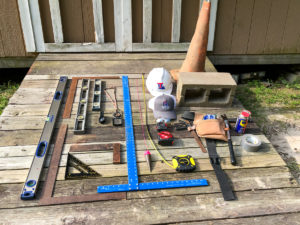NEWS
Top 5 – Tools for engineering and construction
Note: During the COVID-19 pandemic, we have the chance to learn a little more about our Louisiana Tech University Family: students, staff, alumni, faculty, and friends. We’ll call it Tech Top 5. Go to LATechSports.com for more Top 5s. #TogetherApart
Jeff Pike
 Jeff Pike is a senior lecturer in civil engineering and construction engineering technology at Louisiana Tech and has professional engineering licenses in Virginia, Texas and Louisiana, and is an active professional engineer in Louisiana. Today he shares with us his Top 5 Tools for Engineering and Construction. He said:
Jeff Pike is a senior lecturer in civil engineering and construction engineering technology at Louisiana Tech and has professional engineering licenses in Virginia, Texas and Louisiana, and is an active professional engineer in Louisiana. Today he shares with us his Top 5 Tools for Engineering and Construction. He said:
“A couple of years ago my youngest son started a job where accurate and precise measurements are critical. We discussed perfect 90-degree angles, leveling, and plumb lines. All of these items compare existing conditions to an absolute truth. There is a way that seems right to a man, but true horizontal and true vertical don’t always line up with what we initially think are true.
“All these items are important to me for engineering and construction, and we even see the Biblical prophet Isaiah pointing out their significance. ‘I will test you with the measuring line of justice and the plumb line of righteousness.’ Tape measures and plumb lines. Go figure.”
- Square: They come in a variety of sizes, but a square is a necessity for measuring and layout. Need to get a right angle? You need a square. It’s great as a rafter square, protractor, saw guide, a straight edge for drawing straight lines, etc. You can get by with one that fits on your belt, but it’s very nice to have the larger version on hand. You just can’t beat it.
- 2. Level: Rather than depending on your “eye” for whether or not something is level, make it right by having a level on site. Center the bubble to ensure true horizontal. It is widely used in surveying and construction to measure height differences by establishing a visual level relationship between two or more points. A built-in telescope and a highly accurate bubble level are used to achieve the necessary accuracy. Modern automatic versions self-compensate for slight errors in the coarse leveling of the instrument and are quicker to use.
- Plumb line: A plumb line is a string with a lead weight or plumb-bob, used to provide a vertical reference line. The early skyscrapers used heavy plumb-bobs hung on a wire in their elevator shafts. It is also used in surveying to set up exactly over a fixed survey marker. Many cathedral spires, domes, and towers still have brass marks inlaid into their floors which signify the center of the structure above.
- Tape Measure: When I was a kid, my mom had to keep an eye on me or I would sneak her sewing cabinet tape measure away like it was my toy. I thought it was so cool, and I still like tape measures today. There are two basic types of tape measures with cases. Spring return pocket tape measures will generally fit in a pocket. Pocket tape measures have a tape 1 to 15 feet in length, sometimes longer, but you’ll need a bigger pocket! A second design is called the long tape. These are cased tape measures with tapes of 25, 50, 75, 100, 200, 300, and even 500 feet in length. You can’t fit these in your pocket!
- Compass: A compass is an instrument used for orientation that shows direction relative to the geographic cardinal directions. North corresponds to 0°, and the angles increase clockwise, so east is 90° degrees, south is 180°, and west is 270°. These numbers allow the compass to show magnetic North or true North. You need to know which way north is, or you’ll be lost on a construction site. More importantly, you need to know True North, or you’ll be lost in life.
Recent Comments